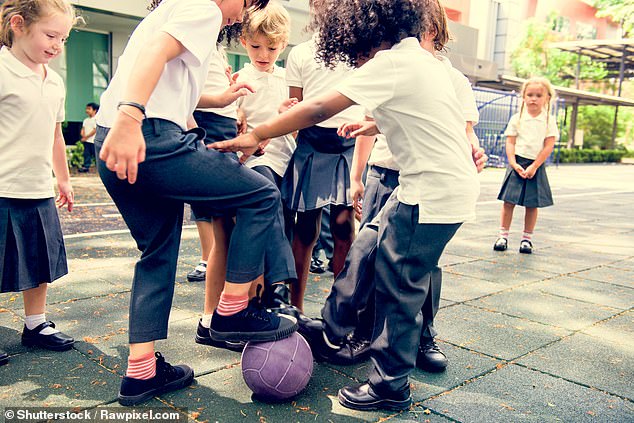- Children Who Wear School Uniforms Like Skirts Are Not As Active, Scientists Say
- Students do not do the hour of moderate intensity exercise recommended by the WHO
School uniforms could prevent children from getting enough exercise, and schools should consider redesigning them to tackle rising obesity, scientists say.
Researchers at the University of Cambridge found that young people who wear uniforms are less likely to get the recommended 60 minutes of daily physical activity.
Girls are more affected than boys because they feel less comfortable engaging in active play while wearing skirts or dresses.
Dr Mairead Ryan said: “We are not trying to suggest a complete ban on uniforms, but rather to present new evidence to support the decision-making.”
‘School communities could consider the design and whether specific features of a uniform could encourage or restrict opportunities for physical activity throughout the day.
Regular physical activity helps support children’s physical and mental well-being. It is also known that more active young people do better in class, say researchers at the University of Cambridge
‘Activities such as walking or cycling to school, recess games, and outdoor games after school can help young people incorporate physical activity into their daily routines.
“That’s why we’re interested in knowing how clothing encourages this type of behavior.”
She added that regular physical activity helps support children’s physical and mental well-being. It is also known that more active young people achieve better results in class.
The study, published in the Journal of Sport and Health Science, used data on the physical activity of 1.1 million young people aged five to 17 years internationally.
It found that in countries where schools require uniforms, fewer students do the hour of moderate-intensity exercise recommended by the World Health Organization (WHO).
There was a consistent gap between the activity levels of boys and girls, with boys being 1.5 times more likely to meet WHO recommendations at all ages.
However, this gap was most marked among children who have to wear uniforms.
Dr Esther van Sluijs, from the Medical Research Council, said: “Girls may feel less confident doing things like cartwheels and cartwheels on the playground, or riding a bike on a windy day, if they wear a skirt or dress.” .
‘Social norms and expectations tend to influence what they feel they can do in these clothes. Unfortunately, when it comes to promoting physical health, that’s a problem.’
Last month, a major study found that almost one in four 10- and 11-year-olds in England are obese, due in part to pandemic lockdowns.

